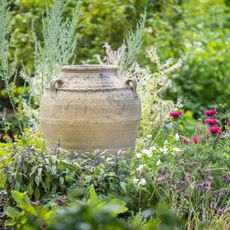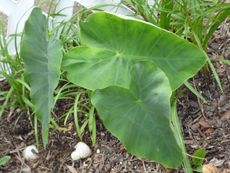Guide To Growing An Elephant Ear Plant Indoors
An elephant ear plant indoors? Create a dramatic indoor focal point in a large room with this mega-leaf tropical plant. You can grow it as a houseplant if you give it warmth and light.


Tips For Growing An Elephant Ear Plant Indoors
Growing an elephant ear plant indoors may seem impossible. You may have seen elephant ear plants growing outside, and they probably impressed you with their mammoth tropical leaves, but can you grow elephant ear as a houseplant?
It is possible to grow an elephant ear plant indoors with a few caveats. Clearly, an indoor elephant ear plant will need some space even though it will likely not attain the size it would outdoors. Interested in an elephant ear plant for indoors? Read on to learn about elephant ear plant care indoors.
About Elephant Ear Plant
Elephant ear plant is the common name for several tropical plants in the arum or aroid (Araceae) family. Elephant ear plants from the genera Colocasi, Alocasia, and Xanthosoma are cultivated as ornamentals, or for their edible starchy corms known as the “potatoes” of the tropics.
A tender, herbaceous perennial with a clumping habit that grows from a corm or tuber, in its native habitat, elephant ears have smooth, waxy leaves. The leaves can grow from 3-9 feet (just under a meter to 2.7 m) in length and 2 feet (61 cm) across or more.
Xanthosoma is native to tropical America while the other genera are indigenous to tropical southern Asia, Indonesia, Malaysia, New Guinea, and areas of Australia and the Pacific Islands. All have similar growth habits and appearance, the most notable being their giant fan-like leaves.
Can Elephant Ears Grow Inside?
The quick answer is yes, elephant ears can be grown indoors. You will however, need some space for the plant and be able to mimic the tropical environmental conditions this aroid thrives in. Plan ahead for the perfect warm, light space that you can provide with plenty of humidity.
Indoor Elephant Ear Plant Care
To grow an elephant ear inside, you will need to simulate the light, water, temperature, humidity, soil and nutrient needs the plant finds in the wild tropics.
Gardening tips, videos, info and more delivered right to your inbox!
Sign up for the Gardening Know How newsletter today and receive a free download of our most popular eBook "How to Grow Delicious Tomatoes."
Light
When grown outside, most varieties of elephant ear plants can be grown in partial shade however, the darker-leaved cultivars do better in full sun. Indoor plants should be grown in an area of bright light although watch out for direct sun which can bleach out or brown the leaf edges.
Water
Elephant ears like moist soil conditions, especially when they’re kept in containers but they do not like to be drowned. However, it’s important you do not allow indoor elephant ears to dry out either. Test the top couple of inches (5 cm) with your fingertip. If the surface is dry, water the plant. Water in small amounts, frequently.
Temperature & Humidity
Since they are from the tropics, elephant plants enjoy warm temperatures and high humidity that needs to be mimicked indoors. These plants cannot tolerate temperatures below 50 F (10 C). Those growing indoors should be kept at 70 F (21 C) or higher with a relative humidity of 50% or greater.
To increase the humidity around your elephant ear plant, set the container on a tray of pebbles, mist the plant with water, or place it near a humidifier.
Soil
Elephant ear plants are heavy feeders and need a moist, rich soil. For indoor plants, a standard, well-draining potting mix amended with nutrient rich compost is a good option.
Fertilizer
Aroids are heavy feeders but especially so when they are container grown. At the blush of the first new growth in the spring, begin feeding the plant with half strength liquid fertilizer once a month during the growing season.
Apply the last fertilizer treatment a couple of weeks before fall and then stop feeding the plant until the spring. You may also incorporate a slow release fertilizer at the start of the growing season.
Pruning
There is no need to prune elephant ear plants except to remove dying leaves. In the fall, most plants will experience dieback wherein the leaves will die. Snip them from the plant at this time, then allow the plant to go dormant until spring. During dormancy, reduce watering and stop fertilizing.
Indoor Elephant Ear Problems
Some of the problems with growing indoor elephant ear plants involve too much or too little water. Too much water fosters fungal disease and root rot. Allowing the plant to dry out stresses it and in some cases enough so that the plant can’t rebound and will die.
Dieback happens more often with outdoor plants (but can happen to those grown inside as well). If you place your plants in a warmer, better-lit area, you may avoid dieback which isn’t really a problem, it’s a natural event. Also, cold drafts can kill the plants so move them away from windows in the winter.
The large, impressive leaves of elephant ear plants are prone to dustiness. Dust covers the pores or “stomata” of the leaves which can weaken the plants and result in disease. Wipe the leaves with a damp cloth once a week to keep the plant healthy.
This plant is also prone to red spider mites. These pests are super tiny and often just look like dust on the foliage. You may notice their delicate webs on the underside of the leaves. Spider mite infestations often occur when a plant has spent the summer outside. Wash the leaves with an insecticidal soap or use neem oil prior to bringing the plant back inside.
Planting & Repotting
Spring is the best time for repotting elephant ears. Repot using a standard potting medium, amended with compost.
Choose a larger pot, no bigger than 3-5 inches (8-13 cm) than the current container. Remove the plant from its current pot and gently loosen the root ball. Set the plant into the new pot, spread the roots out, and fill it in with new potting medium. Make sure the soil level is the same as it was in the old pot. Water the newly potted elephant ear.
Elephant Ear Plant Toxicity
Elephant ear plants contain calcium oxalate crystals in their sap. If people or animals ingest the sap, they can become very ill. The sap is rarely fatal but will cause unpleasant side effects.
Types of Elephant Ear Plants for Indoor Growing
Both Colocasia and Alocasia can be grown in the garden or in containers, although Alocasia is most commonly used as a houseplant.
Some Alocasias are great for growing inside include Black Velvet, Frydeck, New Guinea Shield, and Dawn, a rare specimen with gorgeous variegated leaves of green and cream.
See our Complete Guide to Houseplants

Amy Grant has been gardening for 30 years and writing for 15. A professional chef and caterer, Amy's area of expertise is culinary gardening.
-
 Front Yard Herb Garden Ideas To Spice Up Your Landscape
Front Yard Herb Garden Ideas To Spice Up Your LandscapeUse your imagination and plant a lovely front yard herb garden. You’ll love the convenience, the fragrance and the beauty, and pollinators will appreciate it.
By Amy Grant
-
 When To Clean Up Garden Beds In Spring To Protect Pollinators
When To Clean Up Garden Beds In Spring To Protect PollinatorsEvery spring, I'm reminded that many species of insects have used my garden as a winter hotel and may not be ready for a wake-up call just yet.
By Teo Spengler
-
 Can You Grow Taro In A Pot – Container Grown Taro Care Guide
Can You Grow Taro In A Pot – Container Grown Taro Care GuideTaro is a water plant, but you don’t need a pond or wetlands in your backyard to grow it. You can successfully grow taro in containers if you do it right. Click here and learn how to grow this plant in containers so you can enjoy the pretty tropical wherever you are.
By Mary Ellen Ellis
-
 Elephant Ear Plant Disease In Gardens: How To Treat Sick Elephant Ears
Elephant Ear Plant Disease In Gardens: How To Treat Sick Elephant EarsElephant ears are often grown for their huge, robust foliage. The leaves are prone to several diseases which mar this ornamental appeal. There are also diseases that can cause crown and root rot. If your plant has disease symptoms, this article can help.
By Bonnie L. Grant
-
 Elephant Ear Control – Ridding The Garden Of Unwanted Elephant Ear Plants
Elephant Ear Control – Ridding The Garden Of Unwanted Elephant Ear PlantsElephant ear plants are most often grown in cooler climates as an annual where they do not become a problem. However, in hot, humid, tropical locations, one little elephant ear plant can all too quickly become a mass of them. How do you get rid of elephant ears? Find out here.
By Darcy Larum
-
 Dividing Elephant Ears: How And When To Divide Elephant Ears
Dividing Elephant Ears: How And When To Divide Elephant EarsElephant ear division is useful to prevent overcrowding, produce more plants in a different location, and enhance plant health. It is important to know when to divide elephant ears to avoid plant injury or poor performance. This article will help.
By Bonnie L. Grant
-
 Growing Taro For Food: How To Grow And Harvest Taro Root
Growing Taro For Food: How To Grow And Harvest Taro RootAnother healthier option to the standard potato chip would be growing and harvesting your own taro roots and then turning them into chips. Want to find out how to grow and harvest taro in your own garden? This article will help get you started.
By Amy Grant
-
 Elephant Ear Plant Types: Learn About Common Elephant Ear Plants
Elephant Ear Plant Types: Learn About Common Elephant Ear PlantsElephant ears are one of those plants whose foliage receives double takes and oohs and aahs. There are different elephant ear plants in four genera available for growing in your landscape. Learn more about them in this article.
By Bonnie L. Grant
-
 Elephant Ear Problems: What To Do With Elephant Ears Taking Over Garden
Elephant Ear Problems: What To Do With Elephant Ears Taking Over GardenDo elephant ears affect nearby plants? There are no allelopathic properties in the corms, but this can be an invasive plant and the excessive size may pose problems for species that live under the giant foliage. Learn more in this article.
By Bonnie L. Grant
-
 Uses Of Dasheen Plants: Learn About Growing Dasheen Taro Plants
Uses Of Dasheen Plants: Learn About Growing Dasheen Taro PlantsYou probably have already heard of dasheen, just with a different name: taro. Check out this article for interesting dasheen plant info including what is dasheen good for and how to grow dasheen. Click here for more.
By Amy Grant